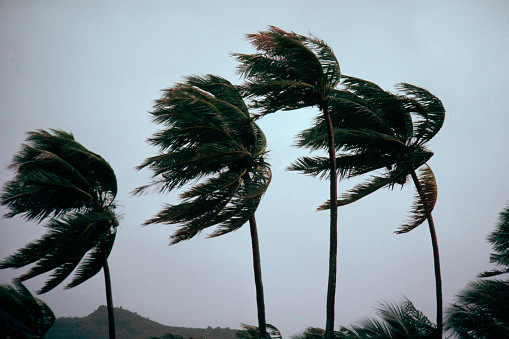
A powerful cyclone that had intensified into the equivalent of a category-five storm has now struck the coastlines of Bangladesh and Myanmar.
Though Cyclone Mocha did not make landfall at Cox's Bazar, the largest refugee camp in the world, as had been first anticipated, it nonetheless destroyed hundreds of makeshift shelters there.
In Myanmar, at least five fatalities have been reported.
There have been no reported casualities in Bangladesh to date.
The storm had largely passed by late Sunday. Kamrul Hasan, a disaster official for Bangladesh, said the cyclone did "no major damage" there, although landslides and floods are still occurring.
In the western Rakhine state, where the storm tore down homes and downed electricity lines, Myanmar appears to have been more directly impacted. Also destroyed were Rohingya refugee camps in Rakhine state.
While there were reports of damaged and fallen structures around the nation, local media in the state of the incident stated that a 14-year-old boy was killed by a falling tree.
A telecom tower was knocked down by powerful winds as the cyclone neared, and power and cellular connections were affected in parts of the state capital Sittwe.
Videos posted to social media also showed billboards blowing off buildings and roofs being blown off houses in Yangon during torrential downpours, BBC reported.
Deadly Cyclone Mocha hits Bangladesh and Myanmar coasthttps://t.co/HGO488OOU4 pic.twitter.com/lGTlANq7vf
— BBC News (World) (@BBCWorld) May 14, 2023
Images from Mrauk U showed metal roofing sheets being blown onto the street, palm trees bending in the wind, and a few people still rushing to find shelter in storm shelters.
According to the Myanmar Red Cross Society, they are "preparing for a major emergency response."
Prior to the cyclone, authorities in Bangladesh had evacuated 750,000 people.
As the cyclone grew stronger, the skies darkened, the winds kicked up, and the rain pelted down, the streets of Cox's Bazar became deserted.
Numerous individuals were jammed into a school that had been converted into a makeshift cyclone shelter.
In the classrooms, pregnant women, young children, the elderly, and the weak crammed themselves into every available space, sleeping on desks and sitting under them.
Many people arrived at the shelter on foot and in rickshaws, bringing their livestock, including cattle, chickens, and goats, as well as mats for sleeping.
They had made a challenging decision to travel from fishing and seaside settlements up to two hours distant.
Sumi Akter, who resides near a riverside, stated, "I didn't want to leave my house."
Sumi and other people we met here claim to have seen recent cyclones firsthand and are used to routinely leaving their houses to the whims of nature.
Low-lying settlements could be inundated by storm surges up to four meters high. Sumi and other people in this place worry that their homes might be flooded.
She added, "I wish the homes we lived in were built more solidly.
Jannat, aged 17, whom we had met the day before in the same shelter, said she too was terrified of what might happen to her home on the riverbank.
Her home was wrecked by the cyclone Sitrang last year, forcing her to spend what little money she had on repairs.
"How can I live if this keeps happening? I can't afford to rebuild it - we are very poor," she said.
The underprivileged at the nearby largest refugee camp in the world were also being punished by nature.
The government of Bangladesh forbids Rohingya refugees from setting up permanent constructions or leaving the camps.
They took cover in rickety bamboo shelters with tarpaulin roofs as the typhoon approached. Some were transferred to communal shelters inside the camps, but these provided only marginally more security.
More than 1,300 shelters, as well as 16 mosques and educational facilities, were damaged by the wind, authorities informed the BBC. In addition to two landslides that caused some damage, trees had fallen in the campgrounds.
Mohammed Ayub's shelter's tarpaulin was ripped off by the wind. His eight-person family is currently living outside in the gloomy, rainy weather.
Mohammed was happy that the camps were spared a direct impact from Cyclone Mocha after spending the days prior in fear of what it might bring.
As far as he was aware, there were no cyclone-related deaths in the camps, according to Mizanur Rahman of the Refugee Relief and Repatriation Commissioner.
Cyclone Mocha, according to forecasters, might be Bangladesh's strongest cyclone in nearly two decades.
According to the Bangladeshi meteorological authority, the maximum sustained wind speed within 75 kilometers (45 miles) of the cyclone's center was around 195 kilometers per hour (120 mph), with gusts and squalls reaching 215 kilometers per hour.
In advance of the storm, surrounding airports had been closed, fishermen had been told to stop working, and 1,500 shelters had been set up as residents of at-risk locations were relocated to safer areas.
Cyclone Nargis tore across Myanmar's southern coastal districts in 2008, killing almost 140,000 people and leaving millions in dire need. The majority of the fatalities were caused by a 3.5-meter water wall that struck the low-lying Irrawaddy Delta.
© 2025 Latin Times. All rights reserved. Do not reproduce without permission.




